The ‘Falkatus’ made on the Kamaz 4911 competition special two-axle chassis is used as a Russian infantry fighting vehicle.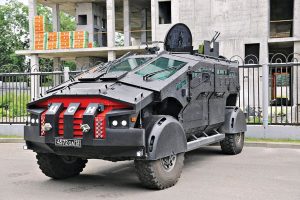
Better known as ‘Karatel’, the Russian infantry fighting vehicle ‘Falkatus’ was developed for the FSB CSN. Built on the Kamaz 4911 competition special chassis, the vehicle has been developed by Moscow-based ZAO ‘Fort-Tekhnologiya’ for the Russian Defense Ministry. With few different pilot models of ‘Falkatus’ made on the Kamaz 4911 competition special two-axle chassis, the interesting part about the vehicle is how the experience and excellent results of the Dakar specials with which  the members of the Kamaz Master Team have been declassifying the world competition in all the races in which they participate for more than a decade was leveraged. In fact, the slight difference between ‘Karatel’ and the ‘Falkatus’ is claimed to be a decade worth of development where the former was an early project on ZIL chassis and never built with armour whereas the later is armoured. Used by FSB for anti-terrorist operations, the full combat weight of ‘Falkatus’ is 12 tonnes.
the members of the Kamaz Master Team have been declassifying the world competition in all the races in which they participate for more than a decade was leveraged. In fact, the slight difference between ‘Karatel’ and the ‘Falkatus’ is claimed to be a decade worth of development where the former was an early project on ZIL chassis and never built with armour whereas the later is armoured. Used by FSB for anti-terrorist operations, the full combat weight of ‘Falkatus’ is 12 tonnes.
With room for some confusion where a majority of people would confuse the ‘Falkatus’ for ‘Karatel’, the Russian infantry fighting vehicle is named after arced Celtic sword or the modern shark’s ancestor, which used to live 320 million years ago. Not a beautiful vehicle to look at from either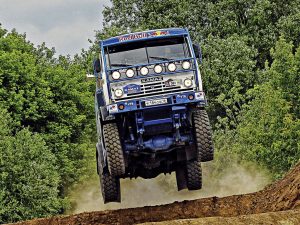 angle, it is quite capable however. A look at the specifications of the Kamaz 4911 competition special chassis and it is clear. Following the debut of mass produced 4310 4 WD at the ‘Jelcz’ rally in Poland in September 1998 by the Kamaz team from Naberezhnye Chelny, the 4911 arrived quite some time later. A natural progression of a close cooperation with the manufacturer’s engineers and testers that resulted in the Kamaz 49205 and Kamaz 49251 as the first truly modified sports trucks based on the most successful vehicles produced by Kamsk automotive plant, the 4911 was born out of much experience and knowledge. It was a result of experimentation
angle, it is quite capable however. A look at the specifications of the Kamaz 4911 competition special chassis and it is clear. Following the debut of mass produced 4310 4 WD at the ‘Jelcz’ rally in Poland in September 1998 by the Kamaz team from Naberezhnye Chelny, the 4911 arrived quite some time later. A natural progression of a close cooperation with the manufacturer’s engineers and testers that resulted in the Kamaz 49205 and Kamaz 49251 as the first truly modified sports trucks based on the most successful vehicles produced by Kamsk automotive plant, the 4911 was born out of much experience and knowledge. It was a result of experimentation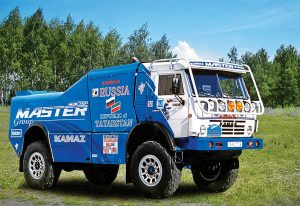 with vehicles that sometimes exceed all imagination and was quite bold.
with vehicles that sometimes exceed all imagination and was quite bold.
Exhibiting strong sporting features, the Kamaz team in 1994 drove a vehicle that was far different from the mass produced ones. It was termed as the Kamaz 49252, and had an engine with power rating of 750 hp. The vehicle had a mid-engine layout and thick 25-inch dia. tyres. It utilised a bevel edged platform of the all-terrain vehicle, used to lower aerodynamic resistance. Winning the tiring Paris-Moscow-Beijing rally, the truck laid the foundation stone for an even more successful next generation model that won the 1996 Paris-Dakar rally a few months later. This truck – the Kamaz 49255, was powered by a 12-cylinder, 1050 hp engine. Such was the power throw of this engine that it ruptured the transmission in 1998 Dakar rally. The 2002 FIA ban on mid-engine configuration put laid to the best plans that the Kamaz rally team had. They went back to the drawing board. In a short time, they came out with the Kamaz 49256 with a 850 hp engine.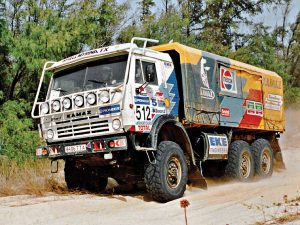 This truck proved to be a bit painful to develop, but succeeded in achieving what it supposed to. It, in fact, paved the way for the Kamaz 4911 ‘Extreme’. A string contender with its excellent transverse performance, maneuverability and dynamics, the 4911 used the classic rectangular platform in-line with the demand of Dakar Rally organisers that the rallying vehicles should be modified out of mass produced ones. In case of trucks, it would be mass produced trucks that carry cargo!
This truck proved to be a bit painful to develop, but succeeded in achieving what it supposed to. It, in fact, paved the way for the Kamaz 4911 ‘Extreme’. A string contender with its excellent transverse performance, maneuverability and dynamics, the 4911 used the classic rectangular platform in-line with the demand of Dakar Rally organisers that the rallying vehicles should be modified out of mass produced ones. In case of trucks, it would be mass produced trucks that carry cargo!
Nicknamed the ‘flying truck’ due to its unique technical and usage qualities, the 4911 floated off the ground at high speeds. It crossed over natural trampolines ‘flying’. Accelerating to 100 kmph from standstill in just ten seconds, the 4911, in order to keep its weight down, employed a thinner yet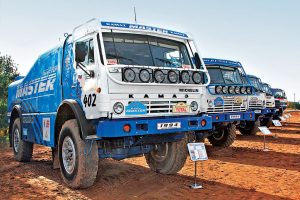 stronger frame. The frame used additional inserts. The extra-long leaf-springs (1900 mm) and modern hydraulic shock absorbers ensures smooth and seemingly comfortable travel. Aiding handling and control too, the 4911, on the basis of its suspension and robust chassis, could jump off heights and land on its tyres, without damage to the vehicle or the crew. Taking gold and bronze in Dakar-Telefonica Rally of 2003, the 4911 ‘Extreme’ out ran the competition by over an hour.
stronger frame. The frame used additional inserts. The extra-long leaf-springs (1900 mm) and modern hydraulic shock absorbers ensures smooth and seemingly comfortable travel. Aiding handling and control too, the 4911, on the basis of its suspension and robust chassis, could jump off heights and land on its tyres, without damage to the vehicle or the crew. Taking gold and bronze in Dakar-Telefonica Rally of 2003, the 4911 ‘Extreme’ out ran the competition by over an hour.



















